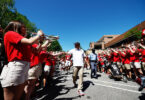After a two-year hiatus, the New Faculty Tour is back.
Thirty-eight new (or nearly new) University of Georgia faculty members spent Aug. 8 to Aug. 12 traveling to the four corners of Georgia to learn about the state’s economy, geography, history, demography, culture and the importance of the university to the state.
The Office of the Vice President for Public Service and Outreach has sponsored the tour annually since 1977, except during tight budget years in 1990, 2003 and 2004. This year the UGA Alumni Association co-sponsored the tour.
“The idea is to introduce new faculty to the state, introduce academic faculty to the service side of the house and for people to have a chance to network,” says Vivian Fisher, associate vice president for public service and outreach and tour leader since 1999. “It’s important for new faculty to get to know other new faculty outside their departments early in their careers.”
A campus legend, the tour has become a model for similar tours by universities around the country.
Each spring, Art Dunning, vice president for public service and outreach, invites administrators to nominate new faculty and high-level professional staff for the tour. Usually, participants must have been at the university for less than three years to qualify.
This year’s group hailed from 17 states and eight nations, and from 10 of UGA’s 15 schools and colleges. It included academic faculty, public service faculty, librarians and health center physicians.
“From small towns relying on agriculture to large cities relying on industry, we had the chance to see it all,” says Chris Hopkins, an extension agent from Toombs County.
Most days the buses were loaded by 6:15 a.m. and heads didn’t hit pillows until after 9 or 10 p.m.
Participants witnessed jet construction, carpet production and candle creation. They ate lunch with the president of North Georgia College and visited the Atlanta University complex and offices of the University System Board of Regents.
Alumni in Monticello, extension agents in Moultrie, and county leaders in Sandersville welcomed the “tourists” into their communities. An evening at Regent Julie Hunt’s Tifton home, a reception hosted by Mexican Consul Gen. Remedios Gomez Arnau and fine dining in Atlanta with the consular corps counted among the highlights.
“On the tour, I saw how diverse the state is and how committed alumni and others in the community are to this university,” says Maureen Grasso, dean of the Graduate School. “I was most impressed, too, with how dedicated the cooperative extension agents are to the people of Georgia.”
The tour also showcased UGA research and outreach in extension, agriculture and fisheries. New faculty walked through a peanut field, visited a clinic for migrant workers, saw dairy farm research and even caught some shrimp on-board Marine Extension’s research vessel, the Georgia Bulldog.
The impact of the tour goes beyond one week: It often leads to life-long friendships and collaborations that affect teaching, research and service.
For example, the group panned for gold and explored the tunnels of Consolidated Gold Mines in Dahlonega.
“I never thought I’d use that experience in class,” says Leigh Willis, assistant professor of sociology. “I teach medical sociology and was talking about risky occupations. When the subject of mines came up, I could talk about what it was like to go down in a mine and about the dangers of certain jobs.”
The tour also gives faculty experiences in the communities that UGA students call “home.”
“When I mentioned I had been in Tifton on the first day of class, one student’s eyes lit up,” says Bryan Reber, assistant professor of public relations. “The student said, ‘That’s my part of the state.’ ”
Every year, new connections are forged among fellow faculty and with Georgia communities. This year was no exception.
A tour of Macon’s Youth Detention Center, which houses juvenile female offenders, prompted Bob Leiter, director of the Georgia Center for Continuing Education, to initiate a project there. He and Brad Cahoon, associate director of independent study, returned to the YDC this month to meet with counselors and the high school principal.
“We’ve identified one or two young women who have finished high school and could further their education through independent study,” Leiter says. The pair plan to offer core freshman classes that could transfer to any place in the University of Georgia system.
“Eventually, we hope to offer the program to more young women and to more facilities,” he says.
On campus, cross-disciplinary connections will be beneficial to UGA students. For example, Silvia Giraudo, a neuroendocrinologist in the College of Family and Consumer Sciences, will give a lecture on nutrition in Willis’ medical sociology class this fall.
“I didn’t even know there was a class like this on campus,” Giraudo says. But a conversation on the bus led to the connection.
“Silvia and I have talked about ‘forwarding students’ to each other’s courses,” Willis adds.
“On campus, you’re not aware of the roles of the institution in the state,” says Doug Toma, associate professor in the Institute of Higher Education. “The tour affirmed deep support for the institution and the fact that we’re doing good work.”
The line for next year’s bus starts forming in March 2006. For more information, contact Vivian Fisher at 542-6167.







